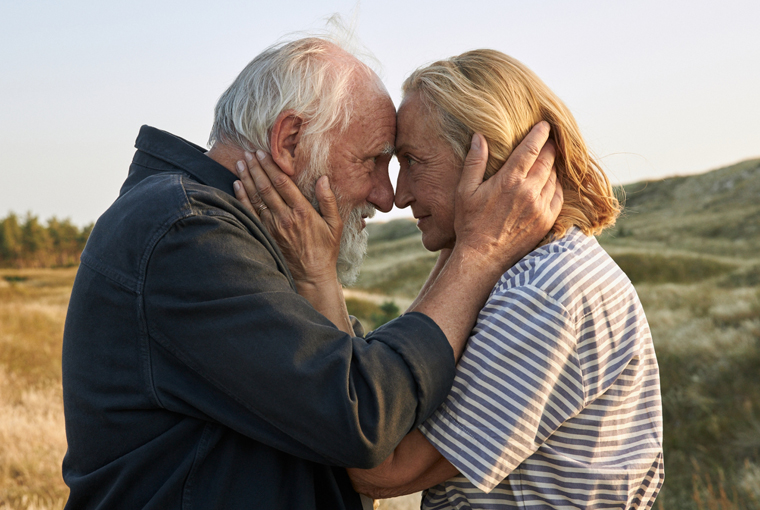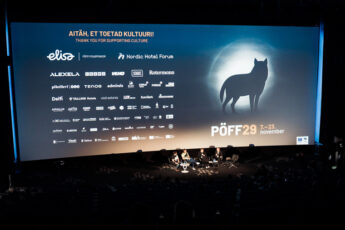“When You’re as Old as We Are, There’s Nothing to Be Embarrassed About Anymore.”
Mantas Verbiejus’ Sand in Your Hair (Smėlis tavi plaukuose, 2025)
Vol. 158 (October 2025) by Jack Page
Frustrated and unfulfilled in her domestic life, retired ballet dancer Malvina (Jūratė Onaitytė) dreams of returning to the theater after a thirty-year hiatus. After she files for divorce from her loyal but reticent husband Vincentas, Malvina flees the confines of her home in Klaipėda and looks to rekindle a relationship with an old flame (an artistic ex-lover named Kripas). As Malvina and Kripas try to relive the affair they once had, their future seems doubtful, despite their unshakably positive outlook. As the pair begin to show signs of dementia, they must face the inexorable reality in front of them: that there are some things in life that even love cannot overcome.
Malvina and Kripas are not your typical elderly couple. Their giddy romance has given them a rejuvenation in which they act as promiscuous teenagers. Malvina steals from her ex-husband and breaks into Kripas’ nursing home, where she believes he is kept against his will. Sneaking outside of his window, Malvina uses her torchlight to send the morse code “SOS” to get Kripas’ attention. He replies solemnly with the word “Forget,” disappointed in himself for forgetting their getaway plans to elope. Malvina’s torchlight taps out “C-O-L-D,” spurring Kripas to let her in. It is a touching display of childhood innocence played by the couple, flirtatious and silly in its execution, where neither one speaks a word (both out of fear of getting caught, but also because they are invested in the game they are playing together).
In one of the film’s more humorous scenes, Malvina and Kripas must break into the nursing home office and steal back his passport so they can take a cruise together. When an orderly appears to inspect the room, Kripas dashes behind a lampshade, believing it will shield his heavy-set frame from view. When he is spotted, the panic-stricken oaf knocks the nurse out, surprised by his own strength. There is a brief awkward pause between Malvina and Kripas, as if to suggest they have gone too far. But realizing it was none other than the nurse who bullied Kripas for soiling his bedsheets, they giggle to themselves and make their escape.
Even their actual dialogue has a juvenile and comedic touch to it. As she disembarks from the bus, Malvina is approached by a confused Kripas, asking “Here are your things?”, to which Malvina replies coquettishly: “In the past.” This quick-witted kind of joke brings a levity and youthfulness to their conversations, perhaps unexpected of an elderly couple. Another amusing memorable line from Kripas is when they break into a beach house. Fearful of the legal repercussions of breaking and entering, Kripas tries to convince Malvina to choose a fisherman’s house because “fisherman don’t rat people out.” He repeats this oddly specific and seemingly random sentiment with deadpan delivery, as if breaking into a fisherman’s residence would completely assuage his worries and also confirm his theory.
Tragically, due to his severe senility, this romantic de-aging is brought to an extreme intensity when Kripas disappears on the beach. No longer a lothario, Kripas is found naked, lying in the fetal position. Malvina has to dress and sooth him as he cries out in anguish from his memory loss. It is not unlike a baby’s tantrum, but acted so aggressively that it really strips Kripas down to his most vulnerable and scared moment. It’s a complex emotion to comprehend – let alone perform – but actor Liubomiras Laucevičius truly embodies a tormented soul that, despite not knowing what to believe, is sure there is something seriously wrong with himself. Ever the optimist, a sentimental Malvina explains to Kripas that the sand in her hair is just like a memory. Even though one day it will be gone, it doesn’t disappear. It is a simple but abstract concept, one that connotes the mutability of remembrance but also a kind of permanence as well. Regardless of whether a memory can be recollected, it is evidence of a happening taking place originally. Even without the memory, certain events occurred indisputably and the past which a memory refers to is what actually matters.
The film uses urban and natural space in a very interesting way. In the interior shots at the beginning, Malvina is tightly framed in cramped corners of the apartment. The walls are adorned with an excessive number of antiques that leave little room for negative space. There is an intentional spatial suffocation that dominates Malvina’s routine; leaning out of windows, wedged in doorways, squashed in car seats. When she departs the city and travels to Neringa, a beautiful location on the Curonian Spit, the world around her literally opens up. Malvina and Kripas traverse through vast pine forests and long stretches of windy sand dunes. The establishing shots are filled with warm sunlight and depth of field, a vitality that seems to match the livelihood of the couple. Interestingly, the only interior setting that works in a similar way is the theater during two interpretive dance sequences. In a dream-like state, Malvina imagines herself and her daughter on a flooded stage, grappling with one another. Their exaggerated gestures punctuate the dance, forceful and hostile. As the camera rotates in parallel with their twisting bodies, the red stalls at the front of the theater and the flood lights are revealed. The blurring of the background gives the impression that the theater space expands infinitely. Even in the drama of their dance, Malvina is given room to breathe and an unlimited freedom of expression. These are also movements that Malvina is not physically capable of any more since her injury, and it is in these imagined scenes where she can undermine her age and her athletic limitations to become the renowned dancer she once was. Even though her ballet skill is no longer there, it hasn’t disappeared entirely. Just like a memory, just like the sand in her hair.




Leave a Comment